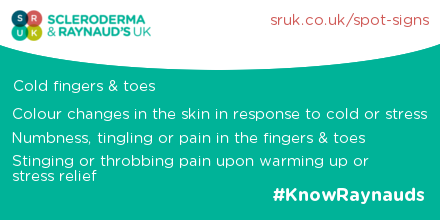What is Raynaud's?
Raynaud's phenomenon is a common condition thought to affect up to ten million people in the UK.
In people who have Raynaud's, the small blood vessels in the extremities are over-sensitive to changes in temperature. This causes a Raynaud's attack where the fingers sometimes change colour, but not always, from white, to blue, to red.
A Raynaud's attack can be a very uncomfortable, possibly painful, process. It can also make everyday tasks, like buttoning a jacket or unzipping a purse, very difficult.
Raynaud's symptoms generally affect the fingers and toes, but all extremities can be involved, including the ears, nose and nipples.
What is scleroderma?
Scleroderma is a rare, chronic disease of the immune system, blood vessels and connective tissue. 2.5 million people worldwide have scleroderma, and in the UK there are 19,000 people diagnosed.
It is an autoimmune condition, meaning the immune system becomes overactive and attacks healthy tissue in the body.
The name of the condition comes from the Greek, 'sclero' for hard, and 'derma' for skin. This hardening of the skin can be one of the first noticeable symptoms of the condition, as the body produces too much collagen.
This excess of collagen can affect the skin, joints, tendons and internal organs. It causes scarring and stops the affected parts of the body from functioning normally.
How to spot the signs
Many of the symptoms of Raynaud's are relatively common, and often not a sign of anything more serious, which is why many people with the condition go undiagnosed for so long.
However, if you or someone you know experience one or more of the following symptoms regularly it's advisable to visit your GP for a consultation. Diagnosis of Raynaud's is straightforward and effective treatments are available in many cases to help manage the condition.


